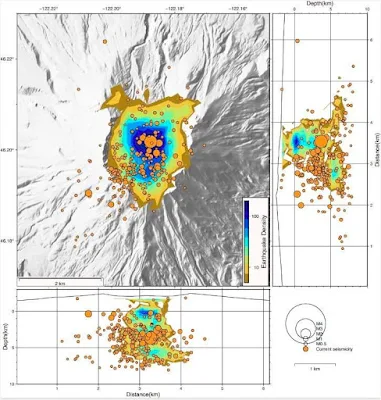400 Earthquakes Recorded Under Mount St. Helens Since Mid-July
About 400 earthquakes have rumbled under Mount St. Helens since mid-July, the largest chain of shakes since the volcano finished erupting in 2008, the U.S. Geological Survey reported last week.
Small magnitude earthquakes, detected only by sensitive equipment, signal a volcano’s “recharging” as magma flows through chambers and cracks deep under the ground, said Wes Thelen, U.S. Geological Survey Cascades Volcano Observatory geophysicist and seismologist.
Between late August and early September, scientists observed 40 to 50 earthquakes per week located between 2.5 to 5 miles below the crater floor, before recently dwindling to 30. To compare, Mount St. Helens averaged roughly 11 quakes per month since 2008.
Although the uptick in activity is not concerning as of yet, seismologists are constantly monitoring St Helens for any changes.
The sharp jolt of seismic activity doesn’t mean an eruption is imminent, Thelen said. Some degree of motion is always happening beneath the surface. Multiple swarms of earthquakes occurred in the late 1980s and early 1990s, and none directly led to eruptions.
 |
| Mount St. Helens is a volcano located in southwestern Washington state. R. Lamb/classicstock/getty Images |
Mount St. Helens’ latest batch of earthquakes was less than a magnitude 1. To put that into perspective, most humans can sense a magnitude 2.5 earthquake within a few miles from where they sit or stand, Thelen said. But it’s subtle. Tremors of this degree could either be an quake or a washing machine in need of some repair.
“People think of background seismic activity as being a constant flat line,” he said. “This is an example that dispels that.”
Mount St. Helens is one of the most understood volcanoes among its 12 other neighbors in the Cascade Range, partly because its eruptive history drew the attention of the science community and, with it, plenty of instrumentation.
Prior to Mount St. Helens’ blast in May 1980, which killed 57 people and permanently altered surrounding ecosystems, only one seismometer was stationed at the volcano, according to the U.S. Geological Survey. Now, there are at least 20 monitoring stations.
Even so, the image of what occurs beneath the Earth’s crust isn’t completely defined. If an MRI can display clear and detailed images of a human body’s internal structure, the conceptual picture of Mount St. Helens’ network of magma deposits is much hazier, Thelen said.
So, what exactly goes into forecasting eruptions?
“A good scientist will always answer every question with, ‘It depends,’ ” Thelen said with a laugh, soon delivering the inevitable answer: “Well, it depends.”
As history illustrates, Mount St. Helens has an eruptive personality. In the past five centuries, the volcano has had four explosive blasts large enough to influence the entire Pacific Northwest, according to the U.S. Geological Survey.
Generally, drastic changes in ground deformation, heat and gas emissions help scientists model potential eruptions. However, each volcano is “its own snowflake” with unique behaviors, making its past a crucial component in forecasting and assessing possible hazards.
The primary signature of volcanic activity is earthquakes, events closely monitored by the Cascades Volcano Observatory and the Pacific Northwest Seismic Network.
 |
| Mount St. Helens volcano (Washington, USA) |
Forecast windows for Mount St. Helens’ potential eruptions are short — as in days. However, with a growing base of knowledge and technology, it is possible for this time frame to expand, albeit slowly, Thelen said.
For example, Mount St. Helens’ eruption that began in 2004 taught scientists that dome growth — or lava extrusions — can occur after long periods of inactivity without obvious signals. They also learned this can persist for years after the eruption concluded in 2008. The nature of this drawn-out event allowed scientists to learn about the volcano’s mechanics and develop new monitoring tools.
The U.S. Geological Survey reports that Mount St. Helens will likely again erupt within our lifetime. But the scope of the volcano’s activity probably won’t compare to what occurred in 1980 now that much of its top is merely just a crater.
“I don’t have a crystal ball, so I can’t say what we’re going to see in the future,” Thelen said. “But (Mount St. Helens) is the most likely volcano to erupt next in the Cascades.”

%20(1).webp)






